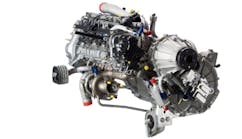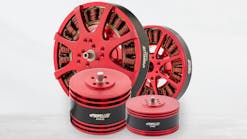Aerospace Manufacturer JPB Système Announces Production Milestone of 5 Million Flight Parts
JPB Système, a leading manufacturer of cost- and time-saving technology solutions for aerospace, aeronautic and other industries, has announced that it has manufactured 5 million separate flight parts since the start of its production operations over 20 years ago.
The milestone predominantly comprises component parts used to produce JPB Système’s innovative LULYLOK B-nut self-locking device and borescope self-locking plug, both of which are supplied to global aircraft engine manufacturers including Safran, Rolls-Royce, GE and Pratt & Whitney. The figure also includes a number of other smaller parts, fittings and fasteners produced across the company’s Industry 4.0 enabled manufacturing facilities.
As an advanced B-nut for fittings, JPB Système’s LULYLOK solution features a unique self-locking device to ensure the sealing of pipes and tubes, thereby preventing loosening and leakage caused by severe vibration and extreme thermal conditions.
Crucially, LULYLOK addresses safety concerns by eliminating the need for a lock-wire or safety cable, tab washers, cotter pins or any other method of fastening to secure the threaded parts within an aircraft’s engine. This eliminates foreign object damage while reducing maintenance costs and installation time.
Similarly, the simple-to-use self-locking borescope plug – which, like LULYLOK, comprises four separate components – eradicates the need for lock-wires when securing an engine’s connections prior to visual inspection. Initially created for Safran in the 1990s, the device reduces human error and overall risk while improving efficiencies by reducing maintenance time from one hour to just 10 seconds.
As has been the case for many years, all of JPB Système’s self-locking devices are deployed by many of the world’s leading aerospace manufacturers across a range of aircraft engine types. These include the CFM56 from GE/Safran joint venture CFM International – acknowledged as the best-selling engine in commercial aviation history and the standard engine across the Airbus A320 and Boeing 737 families; as well as CFM’s LEAP-1A, 1B and 1C engines, Pratt & Whitney’s GTF and Rolls-Royce’s Trent 1000 for the Boeing 787 Dreamliner.
“Some of our industry-renowned lock-wireless devices are now into their third decade of deployment among leading aircraft engine companies, underscoring their uniqueness and longevity in addressing a simple yet vital role,” says Damien Marc, CEO, JPB Système. “Reaching this impressive landmark figure underscores their continued importance as a robust, high-quality and easy-to-use solution to increasing an aircraft engine’s cost effectiveness and safety.”
Despite the general impact on the aerospace industry during the recent COVID pandemic, JPB Système, weathered the storm and even managed to maintain headcount across its workforce. Indeed, in recent years, the company has enjoyed strong manufacturing growth across its production operations and anticipates a 25% increase for 2023, bucking an industry trend and vindicating the milestone announced.
Beyond aerospace, the functionality attributes of JPB’s lock-wireless devices also address and overcome MRO challenges for manufacturers operating in other sectors, among them automotive, railway, marine and oil & gas.





